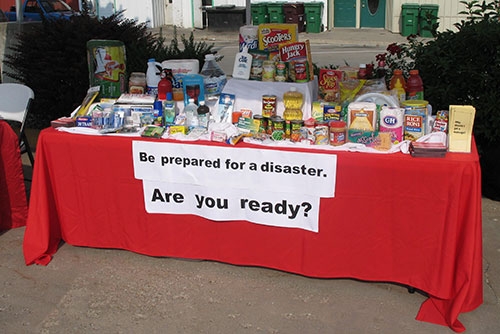You are here
Home ›September to be observed as National Preparedness Month; Are you prepared for a disaster or emergency?

Veterans Memorial Hospital Community and Home Care - Allamakee Public Health is looking ahead to the month of September which is National Preparedness Month, to raise awareness about the importance of preparing for disasters and emergencies that could happen at any time.
“We want to encourage everyone in the area to remember to have a preparedness plan because disasters do happen,” states Sheryl Darling-Mooney, RN, Allamakee Public Health Supervisor. “In the wake of the devastation in Maui, we felt this was a good time to remind the public to have a plan. We can have very volatile weather in the Midwest and we encourage everyone to follow these suggestions from Ready.gov, to make a plan and be ready, just in case.”
First and foremost, Ready.gov encourages each family to establish a meeting place that’s familiar and easy to find, to reconnect if separated. Families should also consider the following questions to be prepared:
- How will I receive emergency alerts and warnings?
- What is my evacuation route?
- What is my family/household communication plan?
- Do I need to update my emergency preparedness kit?
Ready.gov warns that after an emergency, you may need to survive on your own for several days. Being prepared means having your own food, water and other supplies to last through those days. A disaster supply kit is a collection of basic items your household may need in the event of an emergency and should include the following:
• Water (one gallon per person per day for several days, for drinking and sanitation)
• Food (at least a several-day supply of non-perishable food)
• Battery-powered or hand crank radio and a NOAA Weather Radio with tone alert
• Flashlight
• First aid kit
• Extra batteries
• Whistle (to signal for help)
• Dust mask (to help filter contaminated air)
• Plastic sheeting and duct tape (to shelter in place)
• Moist towelettes, garbage bags and plastic ties (for personal sanitation)
• Wrench or pliers (to turn off utilities)
• Manual can opener (for food)
• Local maps
• Cell phone with chargers and a backup battery
Supply kits should be stored in airtight plastic bags, then put the entire supplies kit in one or two plastic bins or duffel bags.
Additional items that may be needed may include the following:
• Soap, hand sanitizer and disinfecting wipes to disinfect surfaces
• Prescription medications and over-the-counter drugs.
• Non-prescription medications such as pain relievers, anti-diarrhea medication, antacids or laxatives
• Prescription eyeglasses and contact lens solution.
• Infant formula, bottles, diapers, wipes and diaper rash cream.
• Pet food and extra water for your pet.
• Cash or traveler’s checks.
• Important family documents such as copies of insurance policies, identification and bank account records saved electronically or in a waterproof, portable container
• Sleeping bag or warm blanket for each person
• Complete change of clothing appropriate for your climate and sturdy shoes
• Fire extinguisher
• Matches in a waterproof container
• Feminine supplies and personal hygiene items
• Mess kits, paper cups, plates, paper towels and plastic utensils
• Paper and pencil
• Books, games, puzzles or other children activities.
Ready.gov also suggests rethinking your family plan and updating your kit each year. “Plan to update your family preparedness plan and stock your emergency preparedness kit by the end of September, National Preparedness Month,” adds Mooney. “Hopefully it will never be needed, but if it does, you will be so thankful you were prepared.”

